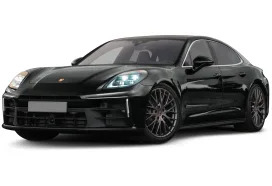Porsche will debut its heavily updated Panamera at the Icons of Porsche Festival in Dubai on November 24. Until then, and probably beyond, the sports sedan that will see out the model's internal combustion era is fine tuning its dynamic responses in testing. The automaker's update on prototype progress also reveals a bit of what's coming. One of the biggest additions is another hybrid trim, taking the total hybrid options to four.
We're told customers have asked for this, with Panamera Hybrid uptake in some markets near 100%. In the U.S., the current menu includes the 455-horsepower Panamera 4 E-Hybrid, the 552-hp Panamera 4S E-Hybrid, and the 690-hp Panamera Turbo S E-Hybrid. The fourth variant is anticipated to follow the template of the new 2024 Cayenne; the SUV's range is topped by a Turbo E-Hybrid powertrain making 729 hp and 700 pound-feet of torque. Hybrid nomenclature could be reworked for the Panamera lineup to accommodate the new entry.
The pure combustion-engined models carry on. Porsche says the base 2.9-liter V6 and 4.0-liter V8 mills have been certified to meet coming emissions standards. The V6 gets a small power bump; the V8's been tweaked with changes like single-scroll turbos instead of twin-scroll.
The hybrid system in every car will enjoy a new, more powerful electric motor integrated into the dual-clutch transmission housing, and the e-motor is capable of higher brake regeneration rates as well. It is being fed by a larger battery, the 17.9-kWh unit swapped for a 25.9-kWh unit. Pure electric driving range is said to have increased by up to 70% in testing. If that figure applies to the 18-mile EPA-rated driving range of our U.S. car, range would increase to just over 30 miles. Charging times will shrink even with the larger battery, an 11-kW onboard charger supplanting the 3.6-kW standard and 7.2-kW optional units.
Despite still riding on the second-generation platform, Porsche calls this the third-generation Panamera thanks to the number of changes. Beyond the powertrain, the suspensions have been overhauled. The standard suspension gets dual-valve dampers that can adjust rebound and compression independently, broadening the range of response in a way that eliminates the needs for a dedicated setting like "Comfort." At the other end, every Panamera will offer a new Porsche Active Ride Suspension that pairs dual-valve dampers with single-chamber air springs, shedding the weight and complexity hydraulic anti-roll bars. Its "active cornering" mode caps dive and squat at 1.5 degrees, and lean during cornering at 3.0 degrees. It can also move through 2.2 vertical inches to improve ease of entry and exit for passengers.
Based on spy shots, cosmetic revisions will include Porsche's fancy new HD Matrix headlights, a full-width taillight and illuminated Porsche logo, resculpted fenders, and new 20- and 21-inch wheels. Other reports declare a redesigned digital dash cluster, relocated shift lever, more comfortable seats, quieter cabin, and more capacious cargo bay are also inbound, as well as the option of more intense synthetic exhaust notes.
A Car and Driver report claims that with Sport Turismo uptake falling below 10%, the wagon body style won't be part of the coming lineup. Toward the end of the decade, the battery-electric Panamera will debut on the Scalable Systems Platform (SSP).
Related Video









Sign in to post
Please sign in to leave a comment.
Continue